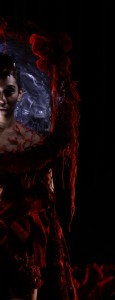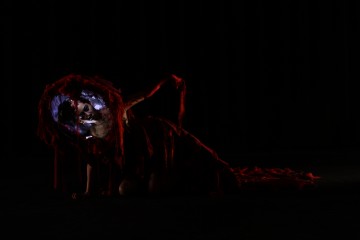– an interview with Ines Ortner (costume designer and director)
What does the Red Sweater Dress symbolize to you?
Industrialization is intrinsically linked to textile technology, and so is the wealth of countries like Britain and the US, based on the invention of the power loom and the Cotton Jenny. Especially since then, women became the main workers in the textile industry with the lowest income. The creation of textiles has been seen as decorative and looked down to by the male dominated art schools and critics. Textile worker are still women for the most part in counties. They are still the lowest payed jobs. Stats Canada just released numbers that attest to the fact that the earnings have been barely raised more that 4% since the last 30 years. This is thanks to the industrialization in which women became the lowest paid earners. My focus for this play was to give Ophelia much more space than the script allows. It was important to me to give Ophelia a loud voice and lots of space. The sweater dress is a pride thing, in your face, loud, beautifully haunting, grotesque, yet poetic.
What does the Red Sweater Dress symbolize in the play?
Ophelia destructed herself completely in part 2. She kills herself again and again by trying to fight the system that men have put in place (industrialization and the wars that are being fought over resources). She only can loose, but she also gives everything. She is obsessively dedicated to her fight and destroys her body in the process. The Dress is her turning inside out. It slows her down but she still keeps on pushing. It is Heiner Mueller who writes her that way: focused, dedicated, relentless beyond reason, in control of her fate, yet unstoppable even if there is no hope for her fight. She is the revolutionary and the dress had to reflect all these trades.
Why is the construction of the dress so difficult?
It is the first time that I did such a big costume that is focused on being upward and big. It is easy for me to get lost at the drawing board. I just love to design, but putting it into reality is a time consuming thinking and a trial and error process. The actual construction is fast but finding the solutions to materials choices, choosing the right construction methods and finding the right materials (hopefully for free) that takes all the time.
Why the LEDs? What’s the reason for having them in the costume?
My main inspiration for the designs come from the Bauhaus theatre school and the philosophies of Oscar Schlemmer. His conceptual work in the 20s evolved around the idea of incorporating the new technologies of the industrial age, like electric light on stage, with the movement of the actors. He designed incredible costumes experimenting with the idea of light and darkness on stage but also with costumes. With the development of LED technology, I was interested to pick up his ideas where he left off. It is nothing new, really, just slightly different, and I have more stuff to play with.
LED also represents the new stage of technology we have reached. Now we are not just carrying technology around with us, we become part of it – almost as if we can’t wait to incorporate them into our bodies. Voluntarily prosthesis, chips, nops, you name it! We like to put that technology in our bodies. I wanted to see how close we can get them to the body and what it does on stage, how much do they communicate without just being spectacle or decoration.
Why the shape and material?
I wanted a big Act 5 Opera dress. It had to incapsulate her as if the next step of the dress would be a bursting, almost like a birth on hold. Although when this would happen, Ophelia’s costume would look like Gertrud’s. Therefore the dress had to anticipate this change so that in the final tableau Ophelia resembles color wise, in shape and stance Gertrud, her elder, the one who has gone this path before her.
When did you start building it? When was it finished?
We started in the beginning of December and we finished it for the photo shoot middle of February
How heavy is it?
The entire dress is more awkward than heavy. The Cage part is light (ish). It is the skirt with its twentyfive-or so sweaters and metal belt/underbild that is heavy. Several kilos I would say.
How does it limit the actors movements?
The main obstruction for Sarah is probably the skirt.
It prevents her to move fast or make tight turns. It slows her down almost to a halt. The focus is on her waist which emphazises the pull from the skirt and gives her an even more wounded appearance. Sarah gives an incredible haunting performance in this costume.
What is your favourite detail of the dress and why is it so significant to you/ the play/ your concept?
I am always drawn to this cold bluish/silver/white light in her cage. It has a such a “nothingness” character: after all this bloody drama in red, there is this calm cool, soothing emptiness, even covering it up with gauze, it always comes through. It is probably safe to say that it is the only sign of hope in this play.


